Diccionario de ocupación es una intervención que se enmarca dentro del proyecto Qualia de la artista Fernanda Aránguiz, un ejercicio permanente de escritura que consiste en la elaboración de definiciones desde una perspectiva personal y que guarda una particularidad en su proceso: las definiciones se generan a partir de la última palabra de la definición anterior, configurando una estructura encadenada.
El grupo de palabras definidas en Diccionario de ocupación establecen un vinculo con el lugar donde se exponen, refiriéndose a su dimensión espacial y, al mismo tiempo, a las cualidades simbólicas que el espacio representa para la artista. El montaje de la exposición trata los muros de esta galería como páginas en blanco dispuestas a configurar una edición, que se compone por 39 definiciones, 37 conceptos, 43 acepciones, 517 palabras, 1.542 signos de puntuación y 2.059 caracteres.
“Dictionary of occupations” is an intervention which is framed within the project “Qualia” a permanent writing exercise that consists in the elaboration of definitions from a personal perspective and which keeps a special feature in its process: the definitions are generated an the basis of the last word of the previous definition, configured as an interlinked structure.
The group of words defined in the “Dictionary of Occupation” establishes a link with the place where they are shown, referring both to a spatial dimension and to the symbolic characteristics that the space represents to the artist. The setting up of the exhibition uses the walls of this gallery as white pages ready to set up an edition, that is composed of 39 definitions, 37 concepts, 43 meanings, 517 words, 1542 punctuation marks, and 2059 characters.
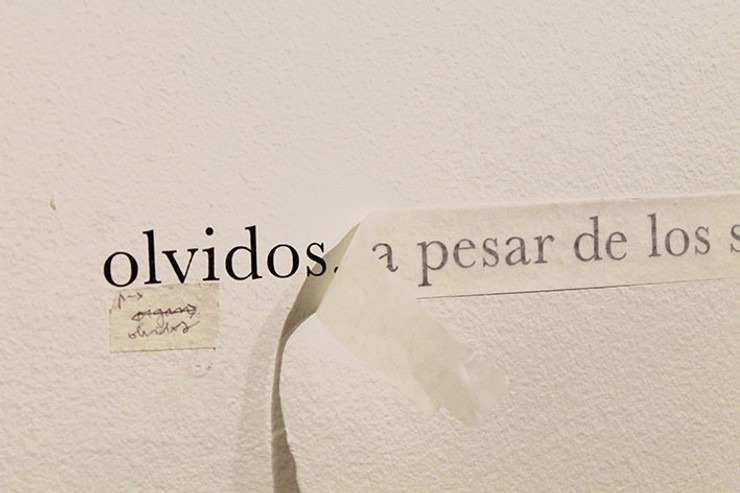
Texto Curatorial
por Naranja Librería
- Acerca de la participación de Naranja Librería en una exposición de arte contemporáneo.
En el momento de acercamiento y planificación del proyecto Qualia de Fernanda Aránguiz, surgió una duda que es legítima y fundamental en la construcción de esta exposición: ¿cuál es la pertinencia en la participación de una librería en la curaduría de una exposición de arte? Esta pregunta nos obliga a esclarecer nuestros propios fundamentos como librería y editorial, en la búsqueda de construir un vínculo con esta obra expuesta en Casa en Blanco.
Nuestro trabajo ha estado profundamente ligado al libro, sin embargo, el libro en el que nos hemos enfocado es aquel en que su soporte y contenido, o bien, contenido y continente logran una comunión tal, que nos invita –desde nuestra condición de lectores– a entenderla como un trabajo analizable desde todas sus aristas, puesto que como decía Ulises Carrión en su obra “El arte nuevo de hacer libros”:
“En el arte viejo el escritor escribe textos.
En el arte nuevo el escritor hace libros”.
Esta frase fundacional de un nuevo tiempo, también funciona como la apertura a un nuevo modo de trabajo que, si bien ha permanecido marginalizado a un circuito aún escueto, ha apuntado a fusionar etapas del proceso creativo y logístico de la cadena del libro, enriqueciendo sus cualidades formales y generando discusiones en torno al texto, la obra y la lectura. Esta libertad o amplitud de posibilidades en torno a lo que puede ser libro o no, inaugura un campo donde los límites son difusos y la definición se construye en el hacer. Este último es considerado el acto reflexivo en el que se cuestiona el rol de cada una de las partes anatómicas de un libro en la búsqueda de integrarlas en la lectura, a su vez entendida como un proceso más amplio que la codificación y desciframiento de un texto, donde todos los elementos materiales están a su servicio, o bien, conforman la lectura misma. Es ese nuestro horizonte.
- Qualia: la definición desplegada cuestionando el soporte.
Para que la lectura sea efectiva, es necesario el reconocimiento del código en que el mensaje se encuentra expresado, estableciendo entre lector y contenido, una relación sostenida por la memoria. Ahora bien, existe un tercer elemento necesario para que la lectura pueda realizarse: el soporte. Si el mensaje no tiene un espacio que lo acoja, nunca podrá ser revelado al lector y, por consiguiente, se deberán escoger otros medios comunicacionales que le permitan ser transmitido.
Desde esta perspectiva, Qualia: diccionario de ocupación cuestiona el soporte tradicional de lectura, transformando el espacio expositivo en un nuevo continente, donde el contenido se despliega en el espacio a partir de palabras definidas que, a su vez, abren nuevos términos a definir. Estas definiciones son realizadas desde un ámbito personal que reflejan el propio devenir de quien define, sin embargo, reconocen el territorio donde se insertan formando vínculos entre el espacio de la interioridad y el espacio arquitectónico.
El acto de desplegar, como también el acto de lectura, se apropian de una sala de exposición utilizando sus muros como soporte del texto. No obstante, el acto de contención de la palabra en los muros no resulta un acto pasivo, sino que se transforma en protagonista del contenido, generando una relación simbiótica entre ambos elementos, donde el texto es afectado por el lugar como el lugar es afectado simbólicamente por el texto, a través de la donación de un tiempo extraordinario, definido por el tiempo del presente montaje.
- La definición tradicional versus la definición propuesta por Qualia.
Definir, desde un aspecto tradicional, implica un acto realizado con exactitud, que describe elementos genéricos y diferenciadores de un concepto.
Es decir, existe en el acto de definir un acuerdo que se traspasa de generación en generación de los hablantes de una lengua y que contiene, en esencia, la inmutabilidad (al menos en los conceptos más abstractos y fundamentales).
Sin embargo, las definiciones de Fernanda Aránguiz atacan esta inmutabilidad desde el entendimiento de que el mundo creado a partir del lenguaje es, en principio, un ejercicio solitario. Es por ello que este ejercicio invita al lector a no permanecer pasivo ante ellas y a no estar siempre de acuerdo; aunque también el lector es invitado a comprender el mundo interior de aquel que define. Fernanda elimina de la definición todo rastro de objetividad, atravesándole su propia historia y su propio presente. Leerlas es ingresar a su mundo, procesos, dilemas y opiniones.
- El lugar.
Esta exposición, realizada con definiciones especialmente recogidas para esta instancia, se pregunta también por el lugar. ¿La exposición puede ser reproducida íntegramente sin cuestionar el soporte que la acoge? Al parecer no, puesto que la arquitectura reconoce el espacio desde la singularidades preexistentes del territorio que la recibe.
Por tanto, esta exposición, al ser acogida por un lugar, cobija también al mundo interior de la artista, quien le regala un tiempo extraordinario y único al describir subjetivamente sus voluntades espaciales y asignaciones emocionales. Es por ello que Diccionario de ocupación tiene el valor de ser la fotografía de un momento interior de la artista, quien se encuentra en constante cambio y que no obliga a un acuerdo o a una coherencia de sus definiciones ni en el tiempo ni en el espacio.
Curatorial Text
By Naranja Librería
1. About the participation of Naranja Librería in a contemporary art exhibition.
In the moment of approaching and planning the project “Qualia” of Fernanda Aranguiz there appeared a legitimate and fundamental doubt for the construction of this exhibition How pertinent is for a bookstore to participate in the guardianship of an art exhibition? The question compels us to clarify our own foundations as a bookstore and editorial, in the search of getting a link with this work shown in Casa en Blanco.
Our work has been deeply linked to the book, however, the book in which we have focused is that in which its support and content or content and container achieve such a communion, that invite us – from our condition of readers- to understand it as a work to be analyses from all its edges as Ulises Carrion said in his work “ The new art of making books” (El Nuevo arte de hacer libros)
“In the old art the writer writes texts
in the new art the writer makes books.”
This foundational sentence of a new time, also works as the start of a new way of working, that, although it has remained marginal in a still narrow circuit, it has attempted to fuse the steps of the creative and logistic process of the production chain of the book, enriching its formal qualities and generating discussions around what may be a book or not, it inaugurates a field where the limits are defuse and the definition is built along with the activity. This last one is considered as a reflexive act in which it is questioned the role of each one of the anatomical parts of the book in search of integrating them to reading which is understood as a wider process than encoding and decoding a text, which all the material elements are at its service, or conform reading itself that is our horizon.
2. Qualia: the definition deployed to question the support.
In order that reading to be effective, it is necessary to recognize the code in which the message is expressed, establishing between the reader and the content, there is a third element necessary so that reading would take place: the support. If the message does not have a space that accepts it, it could never be revealed to the reader and so, other media should be chosen which allow it to be transmitted.
From this perspective, Qualia: occupational dictionary questions the traditional reading support, transforming the expositive space in a new continent, where the container is shown in the expository space from defined words , which in turn open new terms to be defined. These definitions are developed from a personal scope which reflexes the personal evolution of the one who makes the definitions, however, they recognize the place where they insert creating links between the inner space of the architectonic space.
The act of deployment, as well as, the reading act, take over an exhibition room using its walls as a support of the text. Even though, the act of containing the word on the walls does not come out as a passive act, but it turns into the protagonist of the content, generating a symbiotic relationship between both elements, where the text is affected by the place in the same manner as the place is symbolically affected by the text, by means of a donation of an extraordinary time, defined by the time of the present installation.
3. The traditional definition versus the definition proposed by Qualia
To define from the traditional aspect, implies and act exactly developed, which describes the generic and differentiating elements of a concept.
That is to say, there is an agreement in the act of defining that is transferred from generation to generation of speakers of a language and that contains, in essence, immutability (at least in the most fundamental and abstract concepts).
However, the Fernanda Aranguiz`s definitions attack this immutability from the understanding that the world created from the languages, is in principle, a lonely exercise. For this reason, this exercise invites the reader not to be passive at them, not to be always in agreement; although the reader is also invited to understand the inner world of the one that makes the definition. Fernanda eliminates from the definition any objectivity traces going through her personal and present story. Reading them is to enter to her world, processes, dilemmas and opinions.
4. The Place
This exhibition, developed with definitions specially collected for this instance, also asks about the place. Can the exhibition be reproduced completely without questioning the support that hosts it? Apparently not, since the architecture recognizes the space from the pre-existing singularities of the territory that receives it.
So, this exhibition as it is hosted by a place, also shelters the artist inner world who gives an extraordinary and unique time subjectively describing its space wills and emotional assignments. That is the reason why the Occupation Dictionary has the value of being the photograph of one of the inner moments of the of the artist, who is always in constant change and who does not compel an agreement or coherence of her definitions neither in time or space.
Imágenes de la inauguración




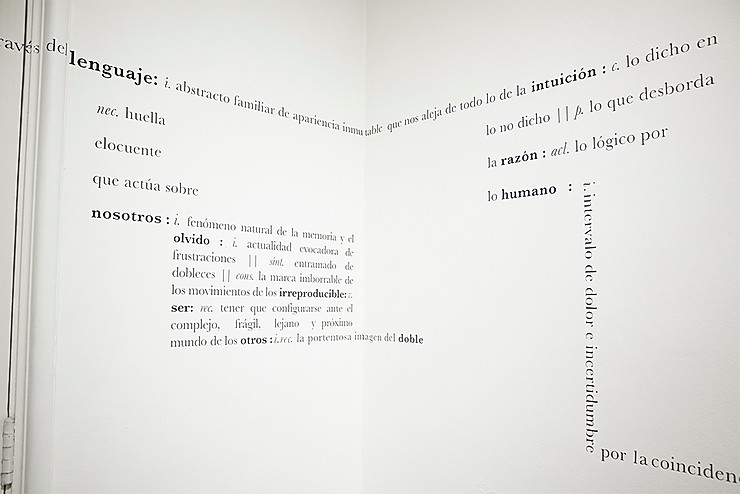
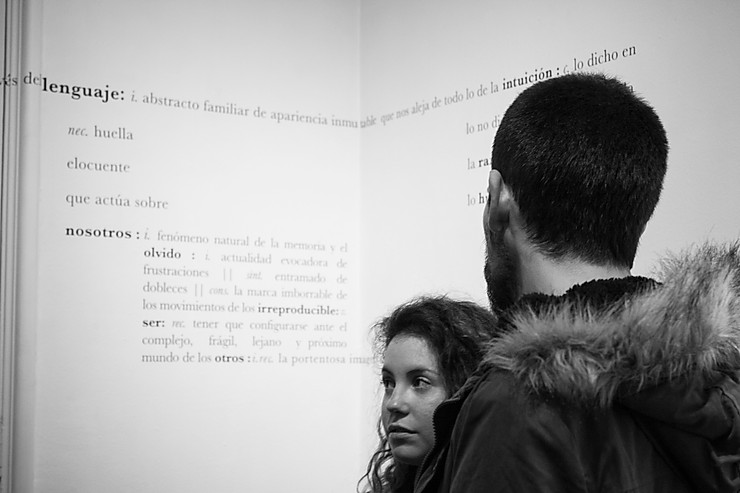
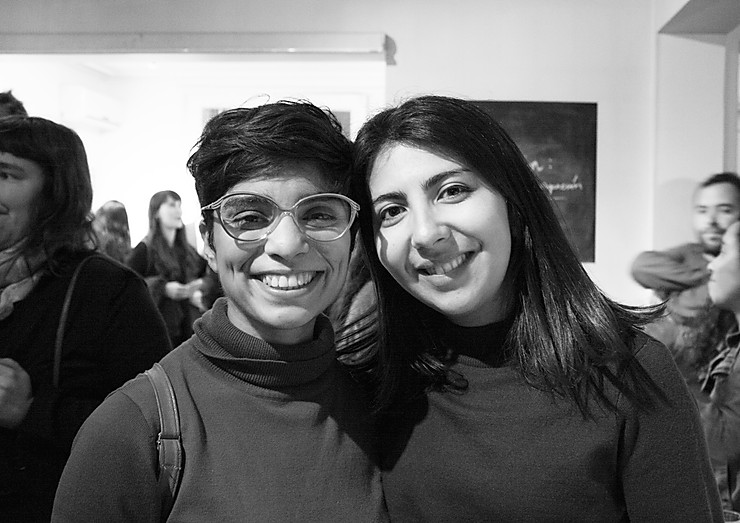
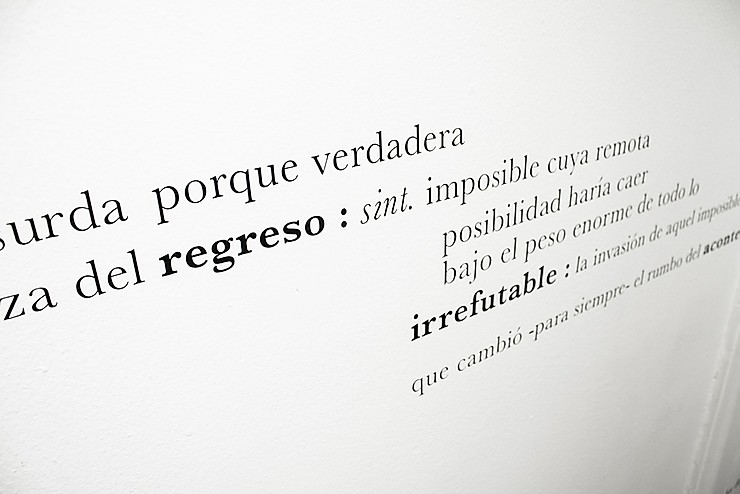
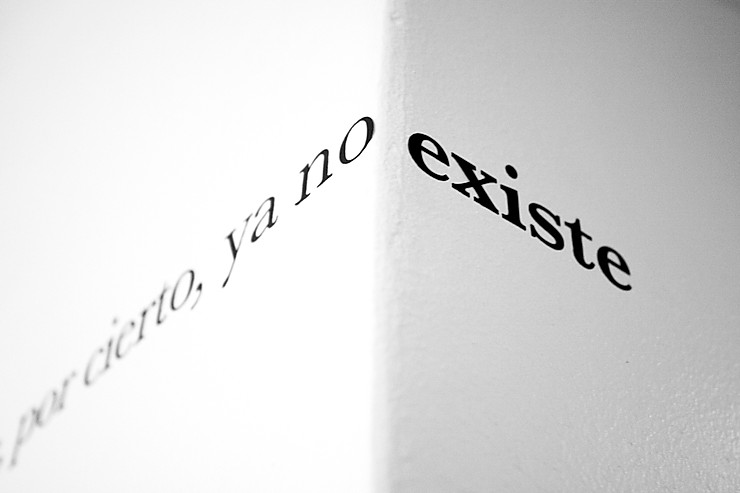
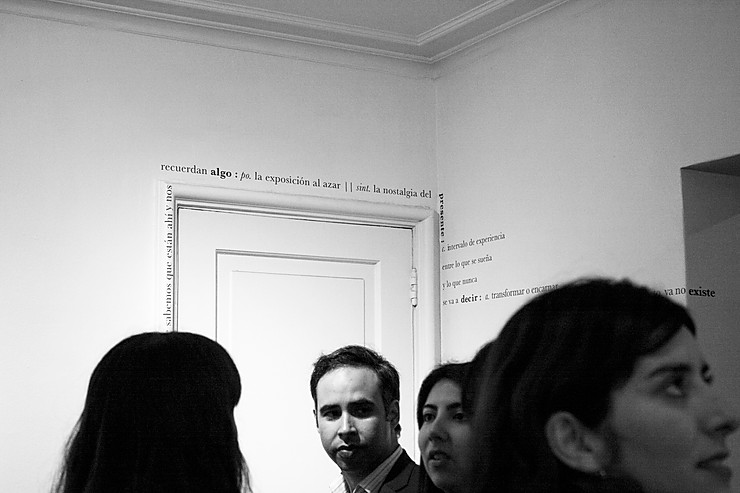
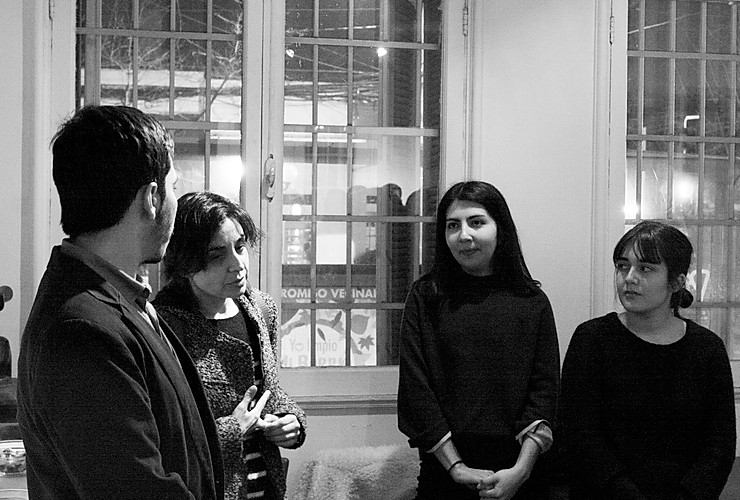
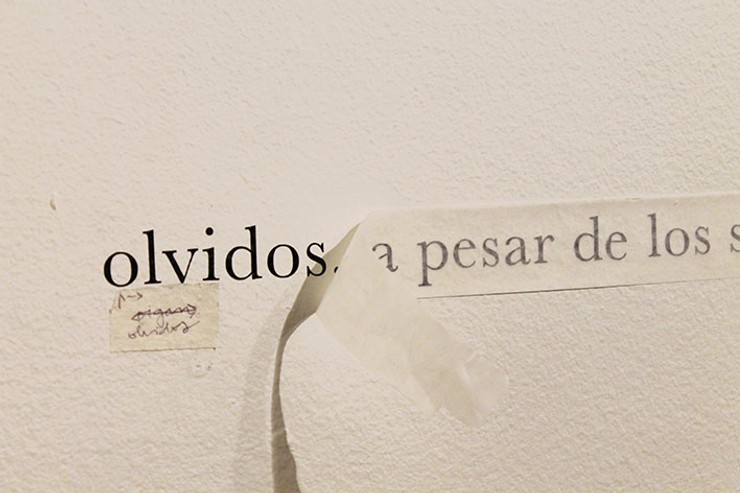
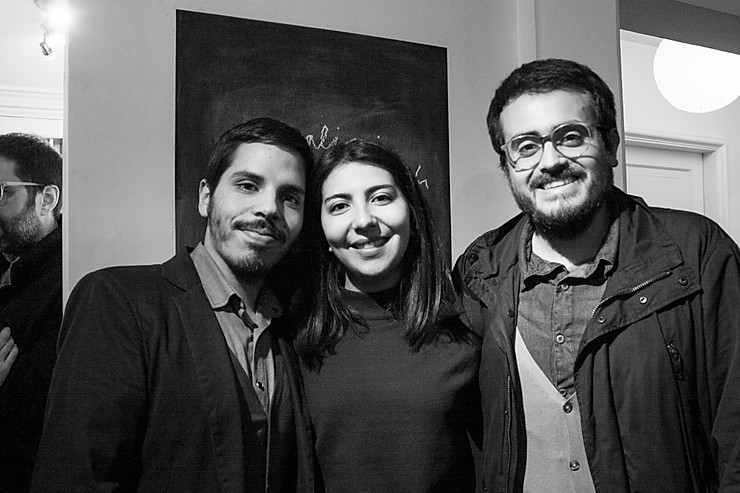
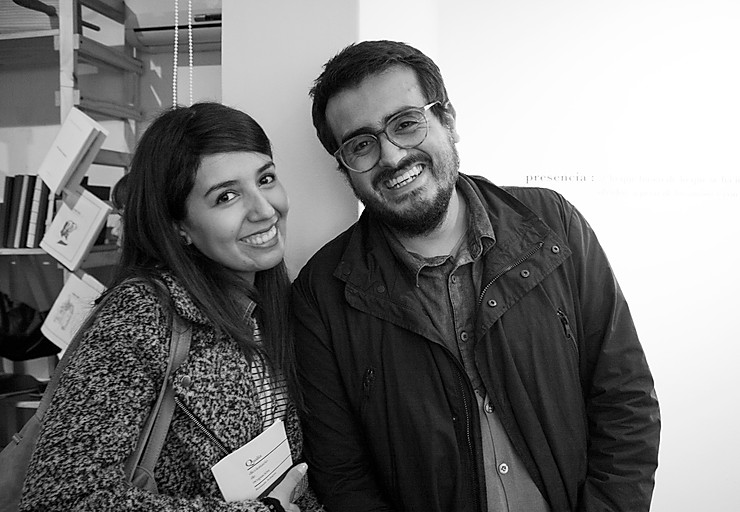
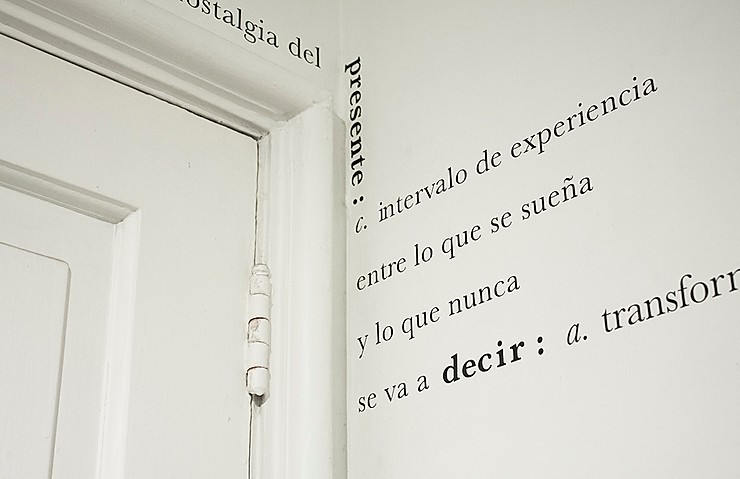
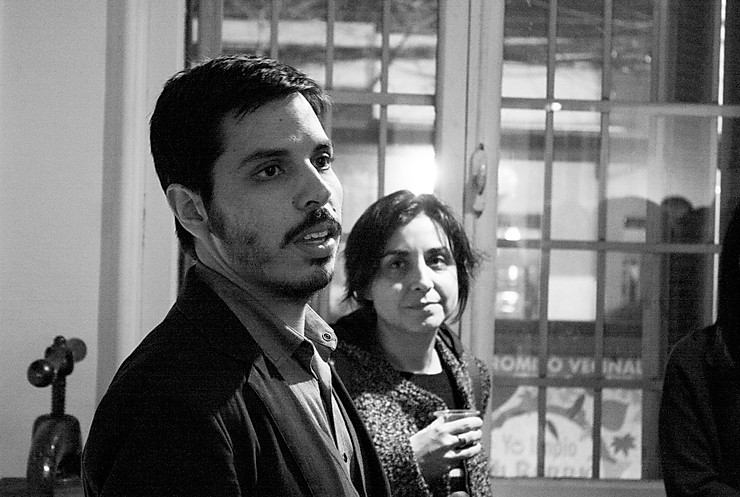
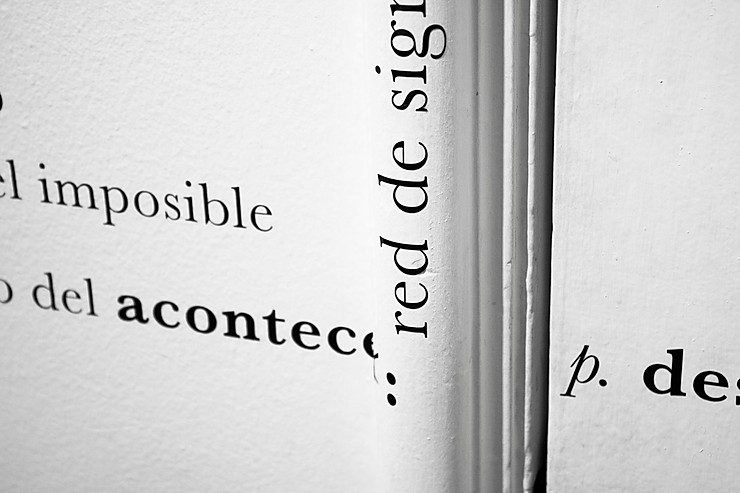
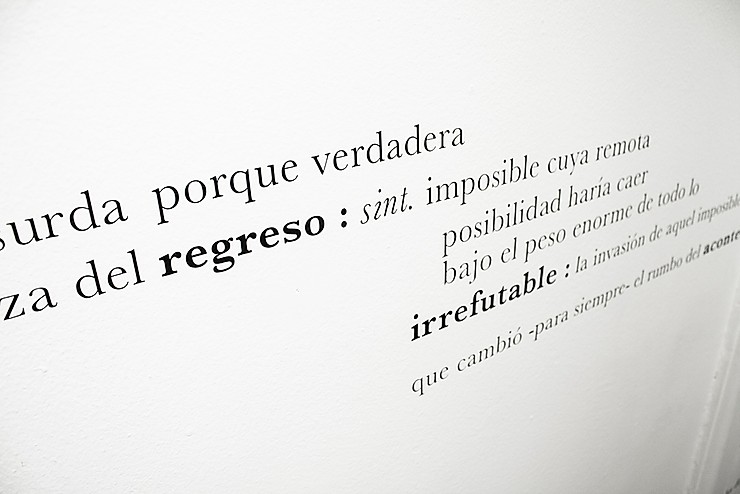
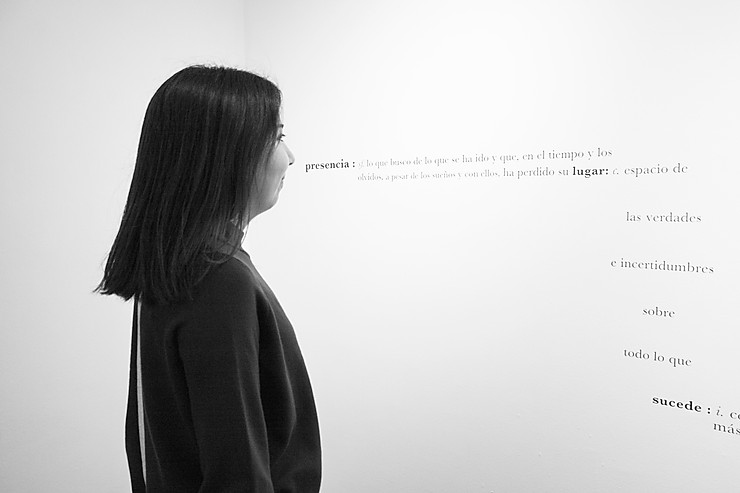
 No hay productos en el carrito.
No hay productos en el carrito.